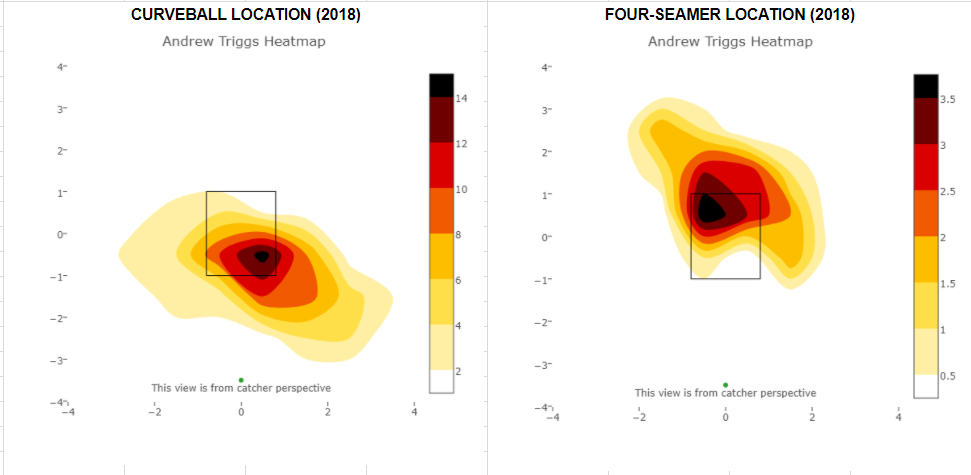“Romantic scouting date” is exactly what it sounds like: Ralph, myself, and a baseball game. We ventured up to slightly warmer weather than Hartford brought us a few weekends ago for more looks at Vladimir Guerrero Jr. and Bo Bichette. Ralph wrote about it (right here) and I had a great time looking at the mechanics of Sean Reid-Foley (TOR) and Dillon Tate (NYY) on my Twitter feed.
For the sake of brevity, let’s get right into two pitchers I’ve had my eye on in this edition of Pitcher Thoughts.
Andrew Triggs
Triggs signature “hop” off of the mound is easy to notice. Some look at their fantasy assets like soul-less stat producers, but I have a heart. I enjoy pitchers with unique attributes, whether statistically or aesthetically. While Triggs’ hop and true sidearm delivery both place him in the aesthetic category of unique, a little strikeout jump early this season has edged up his profile to the point of relevance.
We’re not talking about Patrick Corbin levels of relevance, or even teammate Sean Manaea levels, but a sinker-ball pitcher with a slider-curveball combination and interesting alterations caught my eye.
Triggs’ slider was his go-to offering last year, a pitch that graded out well per Fangraphs’ Pitch Value metric, but even his elevated usage of the pitch couldn’t get him above 7 K/9. Come 2018, the righty has made his curveball the featured breaker, continued hurling a steady diet of sinkers, and added a four-seam fastball and changeup, the latter exclusively to left-handed hitters.
We typically don’t see a pitcher take a pitch, that on results alone, we’d consider “plus,” and decrease its usage. In fact, the majority of pitchers the industry has gravitated towards in the early going have actually embraced their best breaking balls (Corbin is a great example).
While I can spin this as negative, wondering why a pitcher would deviate from a successful pitch, the positive train of thought is equally as satisfying: Triggs has a feel two breaking balls. Even if we haven’t seen both pitches succeed concurrently (his slider has been mediocre this season), it’s feel nonetheless.
My claim of feel is moderately backed up by his standing on spin rate leaderboards and his location, particularly with his curveball, after a year where his slider stole the show. Spin isn’t the end-all-be-all of pitch effectiveness, but it’s a useful data point given research done to show the connection of spin to break and eventually to whiffs.
Triggs’ curveball sits in the 86th percentile of the league among pitchers who have thrown curves at least 25 times. He’s been able to locate the pitch well this season, but the same can’t be said for his slider, which has been around the plate and elevated more than he would like (source: BaseballSavant).
Yet elevation is something he has embraced with the four-seamer he added, locating it consistently in the upper third of the zone. Below is a visual of this location for Triggs – good curveball location with upper-third fastball location. The theory behind this is simply to vary the eye level of a hitter. Even if a pitch isn’t “tunneled” well – which I often go to when talking about changeups – it can still be effective simply because of the variation in location in the zone.

I often find pitchers like Triggs and put them in a part of my brain that cites success as an effect of alteration, but the alteration itself isn’t met with changes that pass the peripheral sniff test (simplest way to tell is his sub-9 percent swinging strike rate, a few ticks below league average). Change something, hitters don’t expect it, and for a short to extended period of time – depending on the change and other variables – success in varying forms will be found. You can even spin this around in the other direction for hitters, the recurring theme being the league’s tendency to adjust back.
Triggs looks like a very different pitcher from last year. If my definition of “very different” possesses a lower bar to clear then so be it, but he’s mixing in two pitches that were obsolete last year, pivoted on his preferred breaking ball, and his results have been more promising than any point prior.
What I’d love to see is the re-development of his slider, a pitch that as you’ll see in the gif below, that has cutter-like action, but enough vertical drop to succeed if placed low in the zone like his curveball. That would give him two plus breaking balls with a sinker that sits right around league average. The product of that change could be whiffs and grounders, something that will never go out of style.
Triggs is a great AL-Only option, a streamer when the matchup feels right, and a deep-league darling. Don’t get too hyped up, but join me in hoping his slider rounds back into form.
https://gfycat.com/PolishedGlossyKob
J.A. Happ
A mini-theme of this column is fastball elevation. It’s something I wrote about recently for the St. Louis Cardinals SB Nation site, Viva El Birdos, I mentioned it in relation to Triggs above, and J.A. Happ has been the poster boy for it this season.
Another stellar start on Sunday (7 IP, 2 ER, 9 K) brings his elite strikeout and swinging strike rate further north. At 35 years old, to say the meddling Happ has found a second (or third?) wind is an understatement.
Travis Sawchik of Fangraphs details what I want to bring up better than I ever could, but I simply want to point out that the nature of what Happ is doing appears sustainable. He’s using a higher-spin fastball than he had last year up in the zone, to generate one of the strongest whiff-inducing heaters we’ll see all season in the league.
On top of that, he has reduced the spin on his sinker – which is a good thing; confusing, I know – and embraced the offering as a ground-ball pitch.
The two features of Happ’s resurgence combine to paint a picture of increased fastball usage, nearly 75 percent to be exact, something that I denounced with Triggs above. It’s a weird formula for success, but while some have taken the path of more breaking balls, others are zagging towards success with elevation and fastballs. As I will always say, baseball is weird and pitchers are even weirder.
Can you think of another pitcher with elevated fastball usage who has had a breakout 2018?
What about that Gerrit Cole guy from that big state in the south?
Razzball’s rest of season Player Rater has Happ as just about an SP3 (38th SP), and a top-150 player (143rd overall). I never thought I’d be comfortable with Happ as my third starter, but the year is 2018 and here we are. I could be convinced that regression is coming, especially given the futility of both his breaking balls, but for the time being, this approach seems odd enough that I think hitters will take issue with adjusting in a timely manner, more issue than they will in adjusting to Triggs.
If you want more pitcher thoughts, check out my Two Strike Approach podcast on Stitcher, iTunes/Podcast App, and Spotify.
If you like prospects, check out all the work Ralph and I do on the Razzball Prospect Podcast channel.
I’ll be back for more next monday and spoiler: it may or may not have to do with spin rate and/or tunneling.
Pull the trigger and follow me on Twitter!
More of my work…


